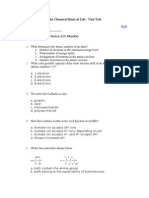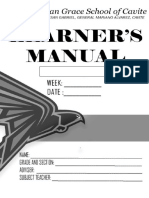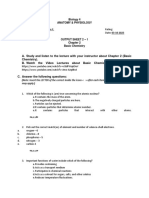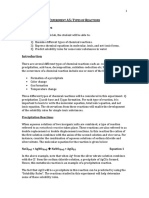0 ratings0% found this document useful (0 votes)
10 viewsBio-Answer Key
Bio-Answer Key
Uploaded by
Sharafa Ashley AbulkhairCopyright:
© All Rights Reserved
Available Formats
Download as DOCX, PDF, TXT or read online from Scribd
Bio-Answer Key
Bio-Answer Key
Uploaded by
Sharafa Ashley Abulkhair0 ratings0% found this document useful (0 votes)
10 views3 pagesOriginal Title
bio-answer key
Copyright
© © All Rights Reserved
Available Formats
DOCX, PDF, TXT or read online from Scribd
Share this document
Did you find this document useful?
Is this content inappropriate?
Copyright:
© All Rights Reserved
Available Formats
Download as DOCX, PDF, TXT or read online from Scribd
Download as docx, pdf, or txt
0 ratings0% found this document useful (0 votes)
10 views3 pagesBio-Answer Key
Bio-Answer Key
Uploaded by
Sharafa Ashley AbulkhairCopyright:
© All Rights Reserved
Available Formats
Download as DOCX, PDF, TXT or read online from Scribd
Download as docx, pdf, or txt
You are on page 1of 3
ABULKHAIR, SHARAFA ASHLEY 12 DIAMOND 4.
Identify the cell to other cells is a function
Lesson 4 Cell Types and Cell Modifications of Carbohydrates.
5. The fluid nature of the membrane is due to
What’s More temperature.
Direction: Match each general tissue category to 6. Cell membranes enclose and define the
the appropriate feature. Write the borders of cells.
letter of your choice before each number. 7. Membrane transport refers to the
collection of mechanisms that regulate the
D. Nervous tissue_ 1. A type of tissue that passage of solutes.
would make up the majority of the brain and spinal 8. Integral protein integrated into the
cord? membrane structure that interacts
B. Epithelium_____ 2. Found in the epidermis extensively with the hydrocarbon chains of
and form the lining of internal organs such as the membrane lipids.
intestines
A. Connective tissue 3. Form the ligaments, What’s New 1-8
tendons, fat and bone 1.
C. Muscular tissue_ 4. A type of tissue that
makes up majority of the heart
What I Have Learned
Direction: Identify which type of connective tissue
(A-C), epithelial tissue (D-F), and
muscle tissue (G-I) is being described.
A. Blood transport oxygen, carbon dioxide,
nutrients and waste through the body by
travelling through the vessels called Lesson 7 Structure and Functions of
arteries and veins. Biological Molecules - Enzymes
B. Tendons and Ligaments is a type of
dense connective tissue that connects What I Have Learned
muscles to bones and connects bone to
bone.fibrous connective tissue Direction: Write the letter of the best answer in the
C. Bone is a type of connective tissue with blank.
one of the hardest extracellular matrixes _____1. It is a substance consumed in the course
that forms a protective structure used for of a chemical reaction.
muscle attachment. a. Reactant
D. Pseudo-stratified columnar found in b. Reagent
respiratory tract (trachea), usually lined c. Reductant
with cilia. d. Oxidant
E. Simple squamous found in air _____2. It is a substance added to test if a
sacs/alveoli of the lungs, capillaries. reaction occurs.
F. Simple columnar found in digestive tract a. Reactant
for secretion and active absorption b. Reagent
G. Cardiac Muscles muscles of the heart; c. Reductant
involuntary movements. d. Oxidant
H. Smooth Muscles involuntary _____3. It contains the element that is oxidized.
contractions of digestive tract like a. Reactant
esophagus, stomach and intestines. b. Reagent
I. Skeletal Muscles striated; voluntary c. Reductant
movements like biceps and abdominal d. Oxidant
muscles. _____4. It contains the element that is reduced.
a. Reactant
Lesson 6 Transport Mechanisms b. Reagent
c. Reductant
What I Have Learned d. Oxidant
Learning Process Activity: Direction: Provide the _____5. It occurs when an atom’s oxidation state
best answer in the blank. decreases during a reaction.
1. The modern understanding of the cellular or a. Oxidation
plasma membrane is referred to as the b. Reduction
fluid mosaic model or fluid mosaics of c. Reduction-Oxidation Reaction
lipids and proteins. d. All are correct.
2. It is composed of a bilayer of _____6. It occurs when an atom’s oxidation state
phospholipid. increases during a reaction.
3. Carbohydrates are attached to some of a. Oxidation
the proteins and lipids on the outward b. Reduction
facing surface of the membrane. c. Reduction-Oxidation Reaction
d. All are correct. _____10. All the statements are not true to the
_____7. Oxidizing agent lowers the oxidation substrate concentration, except for
number of a given element. a. This factor at an optimum level, near neutral,
a. True causes enzymes to catalyze a
b. False reaction most rapidly.
_____8. The following are true to oxidation- b. Changing this factor outside the enzyme’s
reduction (redox) reaction except for optimum range will slow enzyme
a. OXIDATION can be removal of hydrogen/ activity.
electropositive element from a c. At the saturation point, the reaction will not
substance. speed up, no matter how much of
b. REDUCTION can be removal of this factor is added.
oxygen/electronegative element from a d. Increasing this factor can cause an enzyme to
substance. lose its shape (denature) and
c. Spontaneous redox reactions are generally stop working.
endothermic. _____11. It is a substance added to test if a
d. All redox reactions involve the transfer of reaction occurs.
electrons from one atom to another. a. Reactant
b. Reagent
Assessment c. Reductant
d. Oxidant
Direction: Write the letter of the best answer in the _____12. It occurs when an atom’s oxidation state
blank. increases during a reaction.
_____1. Catalyze group transfer reactions; often a. Oxidation
require coenzymes. b. Reduction
a. Transferases c. Reduction-Oxidation Reaction
_____2. Where is the reaction catalyzed in an d. All are correct.
enzyme? _____13. Oxidizing agent lowers the oxidation
b. Active site number of a given element.
_____3. Lysis of substrate; produce contains a. True
double bond. b. False
c. Lyases _____14. The following are true to oxidation-
_____4. This is true to temperature as a factor of reduction (redox) reaction except for
enzymatic reaction. a. OXIDATION can be removal of hydrogen/
d. Increasing this factor can cause an enzyme electropositive element from a
to lose its shape (denature) and substance.
stop working. b. REDUCTION can be removal of
_____5. Enzymes are described as all of the oxygen/electronegative element from a
above except substance.
a. micromolecule c. Spontaneous redox reactions are generally
b. macromolecule endothermic.
c. stereospecific d. All redox reactions involve the transfer of
d. having a defined amino acid sequence electrons from one atom to another.
_____6. It refers to active forms from one of the 3233
inactive enzymes. _____15. It is a substance consumed in the
a. Apoenzyme course of a chemical reaction.
b. Holoenzyme a. Reactant
c. Cofactor b. Reagent
d. Coenzyme c. Reductant
_____7. Enzymes described having a typically d. Oxidant
long amino acid sequence of about? _____16. It regulates the rate of many metabolic
a. 100-400 pathways.
b. 100-500 a. Feedback inhibition
c. 100-600 b. Noncompetitive inhibitors.
d. 100-700 c. Competitive inhibitor.
_____8. It occurs when an atom’s oxidation state d. Substrate Concentration
decreases during a reaction. _____17. It can bind to an enzyme’s active site
a. Oxidation and compete with substrate.
b. Reduction a. Feedback inhibition
c. Reduction-Oxidation Reaction b. Noncompetitive inhibitors.
d. All are correct. c. Competitive inhibitor
_____9. It contains the element that is oxidized. d. Substrate Concentration
a. Reactant _____18. It contains the element that is reduced.
b. Reagent a. Reactant
c. Reductant b. Reagent
d. Oxidant c. Reductant
d. Oxidant
_____19. They attach to the enzyme at an
allosteric site
a. Feedback inhibition
b. Noncompetitive inhibitors
c. Competitive inhibitor
d. Substrate Concentration
_____20. This is true to pH, except for
a. This factor at an optimum level, near neutral,
causes enzymes to catalyze a
reaction most rapidly.
b. Changing this factor outside the enzyme’s
optimum range will slow enzyme
activity.
c. At the saturation point, the reaction will not
speed up, no matter how much of
this factor is added.
d. Increasing this factor can cause an enzyme to
lose its shape (denature) and
stop working
You might also like
- 2nd Quarter FINAL EXAM General Biology 1Document2 pages2nd Quarter FINAL EXAM General Biology 1Cherrina Aguila82% (11)
- Kinetic Study of Lipid Oxidation in Roasted Coffee11estudio Cinetico de La Oxidacion de Lipidos en Cafe TostadoDocument8 pagesKinetic Study of Lipid Oxidation in Roasted Coffee11estudio Cinetico de La Oxidacion de Lipidos en Cafe TostadoRonaldo SantosNo ratings yet
- Chapter 6 Practice TestDocument5 pagesChapter 6 Practice TestLogan ParkisonNo ratings yet
- 2020 UST MBR BiochemistryDocument77 pages2020 UST MBR BiochemistryLorealLunaNo ratings yet
- AP Biology 1st Semester Final Exam Review-2011.2012Document13 pagesAP Biology 1st Semester Final Exam Review-2011.2012Jessica ShinNo ratings yet
- Anatomy and Physiology Exam CompilationsDocument7 pagesAnatomy and Physiology Exam CompilationsRomeo Rivera100% (6)
- Final Assignment BilogyDocument3 pagesFinal Assignment BilogySharafa Ashley AbulkhairNo ratings yet
- GB1 QuestionsDocument9 pagesGB1 QuestionsJanine CambaNo ratings yet
- ICFES-type questions Biology 7°Document2 pagesICFES-type questions Biology 7°ScribdTranslationsNo ratings yet
- Biochem - (With Answers and Achievement Chart)Document11 pagesBiochem - (With Answers and Achievement Chart)Valine Cysteine MethionineNo ratings yet
- Las Q3 WK7 PDFDocument7 pagesLas Q3 WK7 PDFPerlyn Del Pilar OduyaNo ratings yet
- I-MULTIPLE CHOICE: Write The Letter of The Correct Answer On The Blank Before Each NumberDocument3 pagesI-MULTIPLE CHOICE: Write The Letter of The Correct Answer On The Blank Before Each NumberMark Anthony Telan Pitogo100% (1)
- Bio 1 - Lesson 8 QuizDocument3 pagesBio 1 - Lesson 8 QuizPaul Omar Pastrano100% (1)
- 2.4 Metabolism and Enzyme: Multiple ChoiceDocument2 pages2.4 Metabolism and Enzyme: Multiple ChoiceMING ZHUNo ratings yet
- Instant Download for Microbiology A Systems Approach 5th Edition Cowan Test Bank 2024 Full Chapters in PDFDocument52 pagesInstant Download for Microbiology A Systems Approach 5th Edition Cowan Test Bank 2024 Full Chapters in PDFbleshwadeld7100% (1)
- Cell Bio Exam - LE - 10 - 11Document5 pagesCell Bio Exam - LE - 10 - 11tinateacherbkNo ratings yet
- Bio SummativeDocument5 pagesBio SummativeCarlJesterAMontinoNo ratings yet
- Practice Chapter TestDocument4 pagesPractice Chapter Testhossam mohamedNo ratings yet
- SBI4Uchap 2 and 3 Review PDFDocument11 pagesSBI4Uchap 2 and 3 Review PDFleafyfun100No ratings yet
- The Chemical Basis of LifeDocument13 pagesThe Chemical Basis of Lifezulfikarleghari100% (1)
- Science 4 RatDocument5 pagesScience 4 RatNicole LarizaNo ratings yet
- SHS-STEM-Bio1-Q1-Week-7-Module-15-Oxidation-Reduction-ReactionsDocument18 pagesSHS-STEM-Bio1-Q1-Week-7-Module-15-Oxidation-Reduction-ReactionsQuilenne Irene VillegasNo ratings yet
- 02_Biochemistry (1)Document4 pages02_Biochemistry (1)valentina.mufeed07No ratings yet
- Science Lesson 2-Activity 1Document4 pagesScience Lesson 2-Activity 1Angelika GabayNo ratings yet
- WEEK 4-HW - CH 7 Worksheet NealDocument4 pagesWEEK 4-HW - CH 7 Worksheet Nealdancer2heart2006No ratings yet
- 2.4 Metabolism and Enzyme: Multiple ChoiceDocument1 page2.4 Metabolism and Enzyme: Multiple ChoiceMING ZHUNo ratings yet
- Ap Biology Mid Term PretestDocument30 pagesAp Biology Mid Term PretestKrisnavimala Krishnan0% (1)
- Atp Adp ActivityDocument2 pagesAtp Adp Activitymnica4962No ratings yet
- Biology Unit 2 Test 1Document6 pagesBiology Unit 2 Test 1api-352384491No ratings yet
- Reviewer in Physical ScienceDocument5 pagesReviewer in Physical SciencexvidertianNo ratings yet
- Unit 1.5 - Biochemistry Test Part 1Document5 pagesUnit 1.5 - Biochemistry Test Part 1Eric ChiangNo ratings yet
- Q1W1-WS1-SubjectGrade - Copy (6)Document2 pagesQ1W1-WS1-SubjectGrade - Copy (6)Tabayoyong, Joshua V.No ratings yet
- The Chemistry of LifeDocument5 pagesThe Chemistry of Lifesmallcassy47No ratings yet
- General Biology: 1-3 (Second Grading)Document8 pagesGeneral Biology: 1-3 (Second Grading)Dhexter Masungsong MirandaNo ratings yet
- Final Exam Chem 50 Organic ChemistryDocument3 pagesFinal Exam Chem 50 Organic ChemistryMaricar DimasNo ratings yet
- Tutorial Module Bio150Document49 pagesTutorial Module Bio1502022863748No ratings yet
- Sum 2, Phy SciDocument2 pagesSum 2, Phy SciJeclyn FilipinasNo ratings yet
- BIOCHEMISTRYDocument4 pagesBIOCHEMISTRYJuno ValentinesNo ratings yet
- 1.8.1 Biochemistry Unit Test-New8by11Document7 pages1.8.1 Biochemistry Unit Test-New8by11Mushtaq Abdinasir DahirNo ratings yet
- 2013 STAAR Review PacketDocument19 pages2013 STAAR Review PacketNashly RamirezNo ratings yet
- Biology Keystone Exam ReviewDocument58 pagesBiology Keystone Exam ReviewLian LzNo ratings yet
- Q2Document3 pagesQ2Aprillyn n LegaspiNo ratings yet
- Biology Keystone Module 1 PracticetestDocument5 pagesBiology Keystone Module 1 PracticetestTalia GelmanNo ratings yet
- Diagnostic Test in Science 7: A. Bonifacio Integrated SchoolDocument2 pagesDiagnostic Test in Science 7: A. Bonifacio Integrated Schoolrose ann chavezNo ratings yet
- Biological Science - Mid Term ExamsDocument3 pagesBiological Science - Mid Term ExamsLadyZeus ZaneZean BayocaNo ratings yet
- A LITTLE CHEMISTRY Chapter 2-1 and 2-2Document5 pagesA LITTLE CHEMISTRY Chapter 2-1 and 2-2Lexi MasseyNo ratings yet
- Final Exam Life Science 2023 For RISODocument5 pagesFinal Exam Life Science 2023 For RISOJoderon NimesNo ratings yet
- General-Biology-Week-7 (1)Document9 pagesGeneral-Biology-Week-7 (1)John Ronald BaquiranNo ratings yet
- Practice Exam 2017 PDFDocument8 pagesPractice Exam 2017 PDFashraf alaqilyNo ratings yet
- Science 10 - Module 35Document10 pagesScience 10 - Module 35Karlyn Kaye SalungaNo ratings yet
- 2nd Physical Science ExamDocument3 pages2nd Physical Science ExamJokaymick LacnoNo ratings yet
- exam form two biologyDocument3 pagesexam form two biologyhassanNo ratings yet
- 201 Homework 4 - Chaps 6 & 8-1-1Document3 pages201 Homework 4 - Chaps 6 & 8-1-1ysqftyvj64No ratings yet
- 201 Homework 4 - Chaps 6 & 8-1-2-1Document3 pages201 Homework 4 - Chaps 6 & 8-1-2-1ysqftyvj64No ratings yet
- BIIODocument4 pagesBIIOTimothy RandallNo ratings yet
- Output Sheet 2 - 1Document4 pagesOutput Sheet 2 - 1Cristine Kaye BandelanNo ratings yet
- CK12 - Powering The CellDocument3 pagesCK12 - Powering The CellDat White Boi Player2No ratings yet
- Free Access to Discover Biology Core Topics 4th Edition Cain Test Bank Chapter AnswersDocument48 pagesFree Access to Discover Biology Core Topics 4th Edition Cain Test Bank Chapter Answersfatouxeswary100% (7)
- 4th Summative Test in Sci10Document2 pages4th Summative Test in Sci10Enrick PestilosNo ratings yet
- O Level Biology Practice Questions And Answers Plant NutritionFrom EverandO Level Biology Practice Questions And Answers Plant NutritionRating: 5 out of 5 stars5/5 (1)
- Department of Chemistry A.M.U., Aligarh: Analytical Chemistry - I CHM 1001Document66 pagesDepartment of Chemistry A.M.U., Aligarh: Analytical Chemistry - I CHM 1001JNo ratings yet
- Wasteless Economic Method of Production of Phenol and AcetoneDocument14 pagesWasteless Economic Method of Production of Phenol and AcetoneSiswand BIn Mohd AliNo ratings yet
- Chem 33 Postlabs Expt 10-13Document11 pagesChem 33 Postlabs Expt 10-13BelaNo ratings yet
- Syllabus - Btech Iit GuwahatiDocument16 pagesSyllabus - Btech Iit GuwahaticoolunderjerkNo ratings yet
- Short Note Chemistry Form 5-Chapter 5 Chemical For ConsumerDocument4 pagesShort Note Chemistry Form 5-Chapter 5 Chemical For Consumersalamah_sabri100% (1)
- Exp 3 - Copper CycleDocument10 pagesExp 3 - Copper CycleEmily YangNo ratings yet
- Tutorial 4 201605 StudentDocument5 pagesTutorial 4 201605 StudentHo Chung YinNo ratings yet
- Thermodynamics PolymersDocument32 pagesThermodynamics Polymersthuron100% (2)
- Li 2011Document6 pagesLi 2011Jair Carmona GonzálezNo ratings yet
- Chemicals From Coal CokingDocument29 pagesChemicals From Coal CokingNatalia Maya100% (1)
- Ass. Simulation EditDocument11 pagesAss. Simulation EditsemdilaNo ratings yet
- 3 LAB ACTIVITY SHEET 3 Precipitation and Solubility 1Document3 pages3 LAB ACTIVITY SHEET 3 Precipitation and Solubility 1Jurel JohnNo ratings yet
- MSC Chemistry SyllabusDocument25 pagesMSC Chemistry SyllabusSathish Kumar KurapatiNo ratings yet
- C - Formation of MineralsDocument12 pagesC - Formation of MineralsyumambilsonNo ratings yet
- Amines Allen HandbookDocument3 pagesAmines Allen Handbookjampaphotos3No ratings yet
- Enthalpy ChangesDocument17 pagesEnthalpy ChangesDoc_Croc100% (1)
- Experiment A5 - Reactions.v2Document15 pagesExperiment A5 - Reactions.v2Chitlet FrancheNo ratings yet
- Xi Worksheet 3-10-23 - 11102023 - 104010Document5 pagesXi Worksheet 3-10-23 - 11102023 - 104010Adithya PramodNo ratings yet
- CBSE Class 11 Chemistry Quick Revision Notes Hydrocarbons: Material Downloaded From - 1 / 2Document2 pagesCBSE Class 11 Chemistry Quick Revision Notes Hydrocarbons: Material Downloaded From - 1 / 2Bibha KumariNo ratings yet
- 2nd Half Book TestDocument12 pages2nd Half Book Testazharalibur123No ratings yet
- Chemistry Pmc-1-36 (Paid) PaperDocument202 pagesChemistry Pmc-1-36 (Paid) PaperHaresh KumarNo ratings yet
- Assignment: Physical ChemistryDocument7 pagesAssignment: Physical ChemistrySam ShubhamNo ratings yet
- Energetics Q + MSDocument32 pagesEnergetics Q + MSmamta2111No ratings yet
- 00 HSC Chemistry 6Document7 pages00 HSC Chemistry 6EL Yonke MontyNo ratings yet
- Aerobic Cellular Respiration Digital Lab PosterDocument1 pageAerobic Cellular Respiration Digital Lab Posterapi-309712203No ratings yet
- IMU CET Exam Pattern and Syllabus 2024 (Released) - Detailed Syllabus, Exam Mode, Best BooksDocument21 pagesIMU CET Exam Pattern and Syllabus 2024 (Released) - Detailed Syllabus, Exam Mode, Best Booksashutoshmeher0123No ratings yet
- WORKSHEET1 (Chemical Equations)Document4 pagesWORKSHEET1 (Chemical Equations)Rica MelchorNo ratings yet
- A02 115Document29 pagesA02 115jaime0% (1)
- Experiment 1Document9 pagesExperiment 1Rizza Mae RaferNo ratings yet

























































































